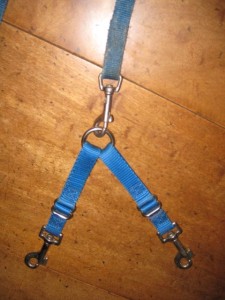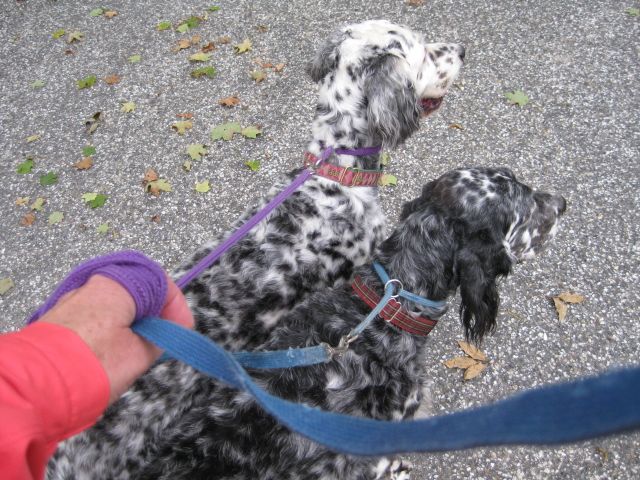I have set a fall training goal for Annie and Lily. Both dogs love to take walks with me on our country roads and I want to offer them more opportunities to do this. I enjoy my walks with the dogs as much as they do. To accomplish this, brace training is in order, then we can do two-for-one. It’s not as simple as leashing both dogs up and heading out the door, en masse. Without proper training, walking two dogs at the same time can turn into chaos. They will be tangling each other up as they move in different directions.
I have spent a long time training each of the dogs separately to heel at my left side. This is step one and prerequisite to brace training. When the heel command is executed properly, the dog’s shoulder is in line with your leg. Not ahead of it. Not behind. Learning to heel properly on a loose lead takes time – and plenty of patience. I have found that learning to heel is the most difficult command for most dogs to master. It is essential for dogs that are training to become certified Bright Spot Therapy Dogs. Often handlers give up on practicing, and make the mistake of accepting a mediocre attempt on the part of the team, person and dog, walking in unison. In these cases, the dogs are mostly pulling ahead of the people. Not pleasant for a leisure walk, a speed-walk for exercise, or for doing therapy dog visits. To practice, the dog starts out in a sit position at your left side. I like to hold the lead handle in my right hand. Leaving some slack in the lead, I hold the rest of the lead in my left hand, which I use as a control lever. Step forward using your left foot, saying, Heel (or With Me, or whatever word or phrase you decide to use consistently when training). If the dog starts to move ahead of you, say, Turn, and make an about turn. The dog will automatically come with you and in the process align with your side.
When I say, Teaching the heel command takes time, I mean lots of time (for some dogs). That applies to my young English Setters Annie and Lily. After over a year of practicing our heeling together as a team (each dog with me at separate times), I feel we are ready for this next step of brace training. Once learned, it will be a time saver, and fun. They love to do things together.
On September 1st, we started with step one of brace training. As pictured above, both dogs are on their own leads. As described earlier, the leads are anchored in my right hand and the rest of the lead is controlled by my left hand. Annie and Lily are both on my left side. Because the dogs had been well-trained in the heel command, walking together, went well, right from the start.
 Today, we moved onto step two: using a couplet. This is a short piece of nylon webbing (leather or chain) with a clip on each end, and a ring in the middle (as seen in the photo). The left clip attaches to the collar of the dog walking on the outside and the right clip attaches to the collar of the dog walking on the inside. I always put the dog that is not as good a heeler on the inside (there are days when this varies between Annie and Lily). The handler is using just one lead now, and that clips to the center ring. I must say, that I was pleasantly surprised at how well it went on our first try. I attribute this to all the advance one-on-one training done with each dog to lead up to this point.
Today, we moved onto step two: using a couplet. This is a short piece of nylon webbing (leather or chain) with a clip on each end, and a ring in the middle (as seen in the photo). The left clip attaches to the collar of the dog walking on the outside and the right clip attaches to the collar of the dog walking on the inside. I always put the dog that is not as good a heeler on the inside (there are days when this varies between Annie and Lily). The handler is using just one lead now, and that clips to the center ring. I must say, that I was pleasantly surprised at how well it went on our first try. I attribute this to all the advance one-on-one training done with each dog to lead up to this point.
Now, step three: practice, practice, practice. Each day, as Annie and Lily get better at this skill, we will walk a bit farther, then farther. Eventually, we will walk our triangle walk together, the three of us in unison, as we have individually. That’s a 3.3 mile loop. A grand goal to set as fall and a new school year commence!
